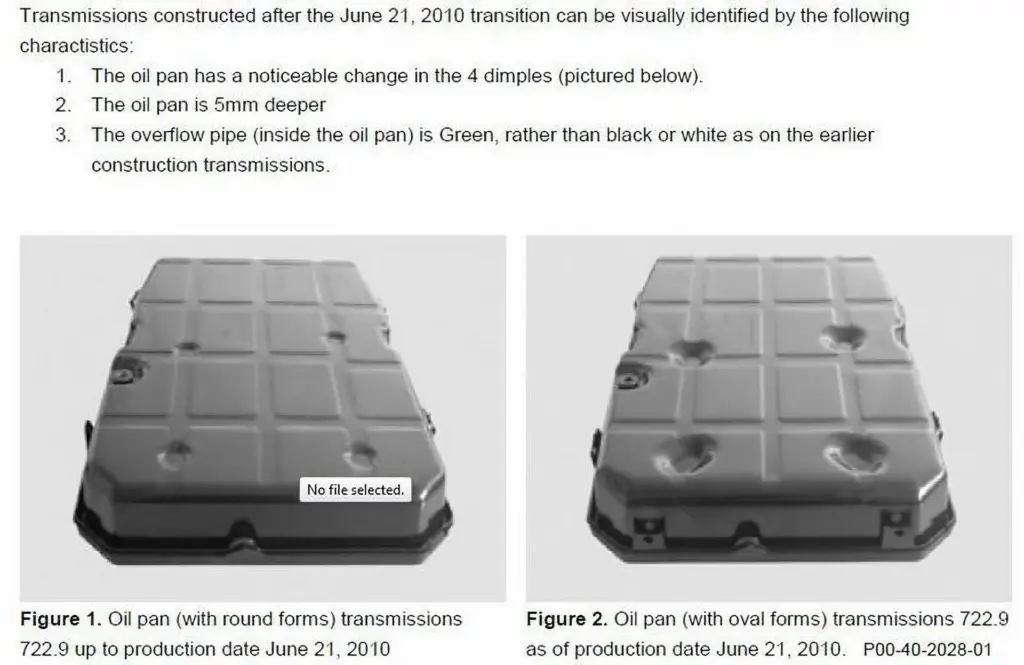The Mercedes-Benz GLK-Class stands as a testament to the brand’s commitment to blending luxury with utility. Launched as a compact luxury SUV, the GLK-Class quickly carved a niche for itself in the competitive automotive market. With its distinctive angular design and the iconic three-pointed star emblem, it became an instant favorite among those seeking a blend of style, comfort, and performance.
Key Takeaways:
| Transmission | Fluid capacity | Fluid type |
|---|---|---|
| 7-speed automatic (722.9, 7G-Tronic except A89 code) | Total fill: 10.2 quarts (9.6 liters) Drain and refill: 6.9 quarts (6.5 liters) | MB 236.14 |
| 7-speed automatic (722.9, 7G-Tronic with A89 code) | Total fill: 9.5 quarts (9 liters) Drain and refill: 6.9 quarts (6.5 liters) | MB 236.15 |
| 6-speed manual (711.6 and 716.6) | 1.6 quarts (1.5 liters) | 75W-85 MB 235.10 |
- Fluid Basics: Using the correct transmission fluid specification is crucial. The two types (MB 236.14 and MB 236.15) are not interchangeable. Using the wrong fluid can lead to transmission issues and potential damage. Always ensure you’re using the correct fluid type for your vehicle’s manufacture date.
- Transmission Fluid’s Role: Proper transmission fluid maintenance is crucial for optimal vehicle performance and longevity.
- Transmission Issues: Common symptoms of transmission problems include erratic gear shifting, unusual noises, warning lights, and fluid leaks. The 7G-Tronic transmission, used in many Mercedes-Benz models, has specific known issues.
- Cost Implications: Changing the transmission fluid in a GLK-Class has an associated cost, influenced by factors like location, labor rates, and additional services. It’s comparatively priced with other luxury vehicles.

Mercedes-Benz, a brand synonymous with innovation and luxury, positioned the GLK-Class to bridge the gap between their sedan offerings and the larger SUVs. Its compact size made it ideal for city driving, while its robust engineering ensured it could handle off-road adventures with ease.
Over the years, the GLK has undergone various refinements, each iteration further enhancing its appeal and solidifying its place in the Mercedes lineup.
But beyond its sleek exterior and plush interiors, the performance of any vehicle hinges significantly on its internal mechanics, with the transmission fluid playing a pivotal role. This fluid serves as the lifeblood of the transmission system, ensuring smooth gear shifts and optimizing driving dynamics.
Proper maintenance and understanding of the transmission fluid are paramount not just for the GLK-Class but for any vehicle. It ensures longevity, reduces wear and tear, and provides drivers with the seamless performance they’ve come to expect from a brand like Mercedes-Benz.
Mercedes-Benz GLK-Class Transmission Fluid Capacity And Type

2013 – 2015 Mercedes-Benz GLK X204 Facelift
- Transmission Fluid Type:
- For models manufactured before June 22, 2010: MB 236.14 ATF (RED in color, also known as ATF 134).
- For models manufactured on or after June 22, 2010: MB 236.15 ATF (BLUE in color, also known as ATF 134 FE specification).
- Fluid Capacity: The fluid capacity can vary based on specific model variations and optional equipment. Typically, the 7G-Tronic transmission holds approximately 9.5 quarts (9 liters). However, always refer to the vehicle’s owner’s manual or consult with a trusted mechanic for the exact capacity.
- Recommended Change Intervals: For optimal performance and longevity, it’s recommended to change the transmission fluid every 40,000 miles or 4 years. However, driving conditions, such as frequent stop-and-go traffic or towing, might necessitate more frequent changes.
2010 – 2012 Mercedes-Benz GLK X204

- Transmission Fluid Type:
- For models manufactured before June 22, 2010: MB 236.14 ATF (RED in color, also known as ATF 134).
- For models manufactured on or after June 22, 2010: MB 236.15 ATF (BLUE in color, also known as ATF 134 FE specification).
- Fluid Capacity: As with the facelift models, the fluid capacity can vary. Typically, the 7G-Tronic transmission for these years also holds between 9.5 quarts and 10.2 quarts.
- Recommended Change Intervals: Similar to the facelift models, it’s advisable to change the transmission fluid every 40,000 miles or 4 years, with adjustments based on driving conditions.
Transmission Fluid Basics
Transmission fluid is more than just a lubricant; it’s the unsung hero of a vehicle’s transmission system. Here are its primary functions:
- Lubrication: At its core, transmission fluid minimizes friction between the various moving parts within the transmission. This lubrication prevents wear and tear, ensuring the components function smoothly and efficiently.
- Cooling: Transmissions generate heat. The fluid helps dissipate this heat, preventing the transmission from overheating. An overheated transmission can lead to reduced performance and, in severe cases, component failure.
- Power Transmission: The fluid aids in transmitting power from the engine to the transmission, facilitating vehicle movement.
- Cleaning: Modern transmission fluids often contain detergents and other additives that help clean the transmission, preventing the buildup of sludge and debris.
- Protection & Sealing: The fluid also protects metal surfaces from wear and corrosion, and its hydraulic properties assist in maintaining seals and preventing leaks.
Different Types of Transmission Fluids Available
There are several types of transmission fluids, each formulated for specific types of transmissions and vehicle requirements:
- Dexron/Mercon: These are the most common types of transmission fluids used for most vehicles, especially older models. They have undergone several iterations, with newer versions offering better performance and longevity.
- Type F: Initially designed for Ford vehicles, this fluid offers unique frictional properties, making it unsuitable for vehicles that don’t specifically require it.
- CVT Fluid: Continuously Variable Transmissions (CVTs) require a specific type of fluid that caters to their unique design and function.
- ATF+4: Specifically designed for certain Chrysler vehicles, this fluid offers enhanced lubrication and protection.
- Synthetic Fluid: These fluids are engineered to offer better performance, especially in extreme temperatures. They also tend to last longer than conventional fluids.
- Manufacturer-Specific Fluids: Many automakers, including Mercedes-Benz, have proprietary transmission fluids designed explicitly for their vehicles. These fluids meet the specific needs and requirements of the brand’s transmission systems.
Recognizing GLK Transmission Issues
Understanding potential transmission problems is crucial for the longevity and performance of your Mercedes-Benz GLK-Class. Early detection can prevent more severe issues and costly repairs.
Here are some common symptoms and their correlation with fluid maintenance and other transmission components:
- Delayed or Erratic Gear Shifting: If your GLK-Class hesitates when shifting gears or shifts unpredictably, this could be a sign of transmission trouble. Smooth gear transitions are a hallmark of a healthy transmission.
- Unusual Noises: Hearing grinding, whining, or clunking sounds, especially when the vehicle is in neutral, can indicate transmission issues.
- Slipping Gears: If the vehicle unexpectedly changes gears without driver input, or struggles to stay in gear, this is a clear sign of a transmission problem.
- Transmission Warning Light: Modern vehicles, including the GLK-Class, are equipped with sensors that monitor the health of the transmission. If there’s a problem, the transmission warning light on the dashboard will illuminate.
- Fluid Leaks: Transmission fluid is vital for the system’s operation. If you notice red (or blue, depending on the fluid type) puddles under your vehicle, it could indicate a leak, which needs immediate attention.
- Burning Smell: Overheating transmission fluid can produce a burnt odor. This smell indicates that the fluid is breaking down and not providing proper lubrication.
- Poor Vehicle Response: If the vehicle doesn’t move when shifted into gear or there’s a noticeable delay, it’s a sign of transmission trouble.
Read Also: Transmission issues signs.
7G-Tronic Specific Issues
The Mercedes 7G-Tronic transmission, used in various Mercedes-Benz models, has been known to experience specific issues:
- Involuntary Gear Shifts: The transmission may shift to neutral without input or refuse to shift into higher gears.
- Transmission Stuck in Gear: In some cases, the transmission may get stuck in one gear, preventing upshifts or downshifts.
- Loss of Power: Drivers might experience a sudden loss of power, where the vehicle doesn’t respond to throttle inputs.
- Fault Codes: The vehicle’s diagnostic system might display fault codes related to the transmission, indicating issues with the torque converter lock-up or the solenoids.
These 7G-Tronic-specific issues can be due to software glitches, internal component wear, or other transmission-related problems. Regular maintenance, including timely fluid changes and software updates, can help mitigate these issues. If you experience any of these symptoms, it’s crucial to consult with a Mercedes-Benz specialist or trusted mechanic.
The Relationship Between Transmission Health and Fluid Maintenance
Transmission fluid plays a pivotal role in ensuring the transmission operates efficiently. Here’s how fluid maintenance relates to transmission health:
- Lubrication: Regularly changing the transmission fluid ensures that the internal components remain well-lubricated, reducing wear and tear.
- Cooling: Fresh transmission fluid effectively dissipates heat, preventing the transmission from overheating.
- Cleaning: New transmission fluid, especially those with detergents, helps clean the transmission, preventing the buildup of sludge and debris.
- Protection: Regular fluid changes ensure that the transmission is protected from corrosion and that seals remain in good condition, preventing leaks.
How Much Does It Cost To Change Transmission Fluid In Mercedes-Benz GLK
Changing the transmission fluid in a luxury vehicle like the Mercedes-Benz GLK-Class is an essential maintenance task that ensures the longevity and optimal performance of the vehicle. However, the cost can vary based on several factors.
The Average Cost for a GLK-Class Transmission Fluid Change
On average, the cost to change the transmission fluid in a Mercedes-Benz GLK-Class ranges from $150 to $350. This price includes both the cost of the fluid itself and the labor charges.
It’s worth noting that Mercedes-Benz vehicles, being luxury models, might have slightly higher maintenance costs than more mainstream brands due to the specialized nature of the service and the quality of the parts and fluids used.
Factors That Can Influence the Overall Cost
- Location: Labor costs can vary significantly based on your geographical location. For instance, getting your transmission fluid changed in urban areas or regions with a higher cost of living might be more expensive than in rural areas.
- Dealership vs. Independent Mechanic: While dealerships offer specialized knowledge and genuine parts, their service charges are typically higher than independent mechanics. However, an independent mechanic with experience in luxury vehicles can provide quality service at a more affordable rate.
- Type of Fluid: The specific transmission fluid type recommended for the GLK-Class (either MB 236.14 or MB 236.15) is a specialized fluid, which can be more expensive than generic transmission fluids. Always ensure the correct fluid type is used to avoid potential transmission issues.
- Additional Services: Some service centers might recommend additional services, such as a transmission flush or replacing the transmission filter, which can add to the overall cost.
- Vehicle Condition: If there are other underlying issues with the transmission, such as leaks or damaged seals, the cost of changing the fluid might increase due to the additional repairs needed.
While the cost of changing the transmission fluid in a Mercedes-Benz GLK-Class can vary, it’s an investment in the vehicle’s health. Regular maintenance not only ensures smooth performance but also prevents more costly repairs in the future. Always consult with trusted service providers and get multiple quotes to ensure you’re getting a fair deal.
DIY: Checking and Changing Transmission Fluid
For those who are mechanically inclined and prefer a hands-on approach, changing the transmission fluid in your Mercedes-Benz GLK-Class can be a rewarding task. However, it’s essential to have the right tools and follow safety precautions to ensure the job is done correctly and safely.
Necessary Tools for the Task:
- Jack and jack stands or a vehicle lift
- Drain pan
- Socket set and ratchet
- Torque wrench
- Transmission fluid funnel
- New transmission filter and gasket (if replaced)
- Mercedes-Benz approved transmission fluid (either MB 236.14 or MB 236.15, depending on the vehicle’s manufacture date)
- Disposable gloves and safety glasses
A Detailed, Step-by-Step Guide to Checking and Replacing the Fluid
- Safety First: Ensure the vehicle is on a level surface. If using a jack, lift the vehicle and secure it with jack stands. Never work under a vehicle supported only by a jack.
- Locate the Transmission Pan: Under the vehicle, find the transmission pan. It’s typically a large, flat metal pan.
- Drain Old Fluid: Position the drain pan beneath the transmission pan. Remove the drain plug using the appropriate socket and allow the old fluid to drain out.
- Remove the Transmission Pan: Once drained, remove the bolts holding the transmission pan in place. This will give you access to the transmission filter.
- Replace the Filter (Optional): If you’re replacing the filter, remove the old one and install the new filter. Ensure it’s seated correctly.
- Clean and Reinstall the Pan: Clean the inside of the transmission pan and the magnet (which collects metal shavings). Replace the gasket, then reinstall the pan and tighten the bolts to the specified torque settings.
- Refill with New Fluid: Using the transmission fluid funnel, pour the new fluid into the transmission fill tube, which is typically located in the engine bay. Ensure you’re using the correct type and amount of fluid.
- Check Fluid Level: Start the vehicle and let it run for a few minutes. With the vehicle in “Park,” pull out the transmission dipstick, wipe it clean, reinsert it, and then pull it out again to check the fluid level. It should be within the “Hot” range.
- Test Drive: Take the vehicle for a short drive to ensure smooth gear shifts. Check for any leaks once you return.
Essential Safety Guidelines to Follow:
- Always wear safety glasses and gloves to protect against splashes.
- Work in a well-ventilated area, away from open flames.
- Ensure the vehicle is securely supported if elevated.
- Dispose of old transmission fluid properly. Many auto parts stores offer recycling services.
- If unsure about any step, consult a professional or refer to the vehicle’s service manual.
For a more detailed walkthrough, especially for the Mercedes 7-speed transmission, you can refer to the FCP Euro’s Service Walkthrough for 722.9 Transmissions. This guide provides in-depth instructions and visual aids to assist DIY enthusiasts.
Frequently Asked Questions
1. How often should I change the transmission fluid in my Mercedes-Benz GLK-Class?
Answer: For most Mercedes-Benz vehicles, including the GLK-Class, it’s recommended to change the transmission fluid every 40,000 miles. However, always refer to your vehicle’s owner’s manual or consult with a Mercedes-Benz service specialist for specific recommendations tailored to your driving conditions and habits.
2. Can I use alternative fluid types other than the recommended MB 236.14 or MB 236.15 for my GLK-Class?
Answer: While there are aftermarket transmission fluids that claim compatibility with Mercedes-Benz specifications, it’s always best to use the manufacturer-recommended fluid. Using the wrong type of fluid can lead to reduced performance, transmission damage, and voided warranties. If considering an alternative, ensure it meets or exceeds the Mercedes-Benz specifications and consult with a trusted mechanic.
3. What are the signs of low or deteriorating transmission fluid in my GLK-Class?
Answer: Low or deteriorating transmission fluid can manifest in several ways:
- Delayed or Erratic Gear Shifting: If the vehicle hesitates when shifting or does so unpredictably, it could be due to low fluid levels or deteriorated fluid.
- Unusual Noises: A grinding or whining noise, especially when the vehicle is in neutral, can indicate transmission issues related to fluid quality or level.
- Transmission Overheating: Overheating can be caused by low fluid levels or deteriorated fluid that’s lost its cooling properties. Overheating can lead to significant transmission damage if not addressed.
- Transmission Warning Light: Modern vehicles, including the GLK-Class, have sensors that monitor transmission health. If there’s a problem, the warning light on the dashboard will illuminate.
- Burning Smell: If you notice a burnt odor, it could be due to overheating transmission fluid, indicating it’s time for a change.
Last update on 2025-12-22 / Affiliate links / Images from Amazon Product Advertising API















